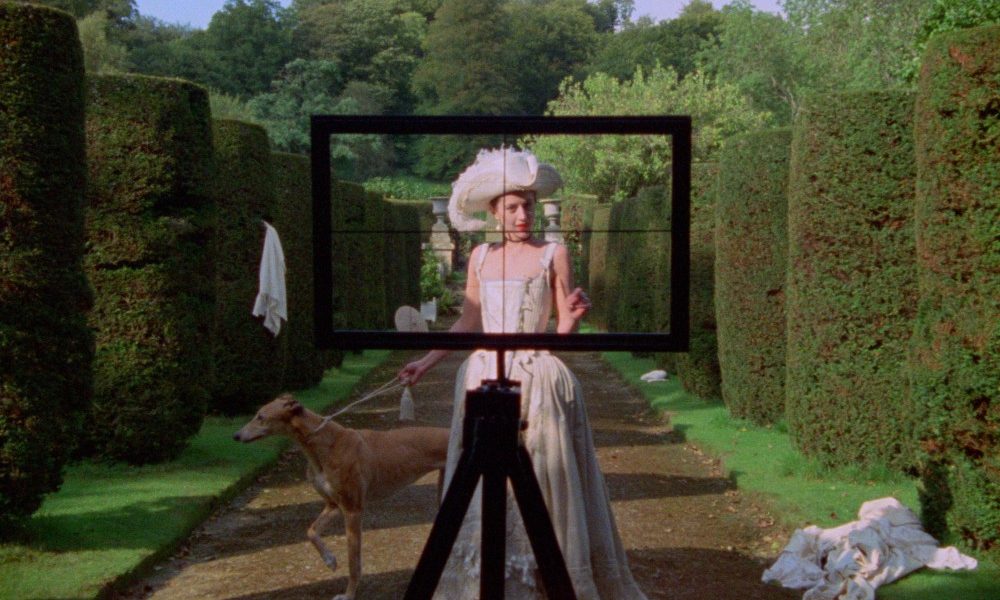Peter Greenaway’s Charged Debut of Murderous Misadventures in and Around a Manor House
DIRECTED BY PETER GREENAWAY/1982
BLU-RAY STREET DATE: JUNE 13, 2023/ZEITGEIST via KINO LORBER
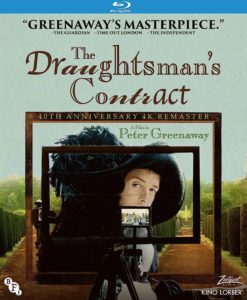
Never mind the color of pomegranates, what of their taste? Phfsst! Eating the rich may or may not sound appetizing in any era, but partaking of the fruit these particular rich tend to yield can be quite the dicey prospect. In his debut feature film, 1982’s The Draughtsman’s Contract, the ever whip-smart and loftily subversive British auteur Peter Greenaway eventually gets around to a metaphoric implementation of the fruit. But then again, when the whole film’s a metaphor, what’s one more?
It’s 1694 in Wiltshire, somewhere near Salisbury, or thereabouts. Aristocracy is highly perched in England, and is proportionately outlandish to the eye. Somehow, big, powdered wigs, ruffles, overcoats, and tights were the height of the masculine power look. The Draughtsman’s Contract fully adopts and sports this ridiculous style ad infinitum. (Or at least through to the end of the film). Is it any coincidence that the most seemingly sensible character is a nude mute mime covered in body paint, impersonating statues and acting the jester? While his presence is never explained, his actions say plenty about this insular, insufferable world.
In extreme contrast to “the living statue”, everyone else runs their yaps incessantly, pontificating and debating, barbing and jabbing over every little thing. Cleverly? Nothing short of most cleverly- and it’s as though they know it. The words, after all, are Greenaway’s. “Your inventory, Louis, is unlimited. Like your long, clean, white breeches, there is nothing of substance in either of them.” “Why is that dutchman waving his arms about? Is he homesick for windmills?” “When your speech is as coarse as your face, Louis, then you sound as impotent by day as you perform by night.” “Those buckets were filled before my mother died. I expect them to be still there, with the same water of thirty years ago, I shouldn’t wonder – mixed with a little of myself, of course. I used to pee like a horse. I still do.” Incessant banter, yes, but the best kind. Punchy, pointed, and dripping with inflated snark.
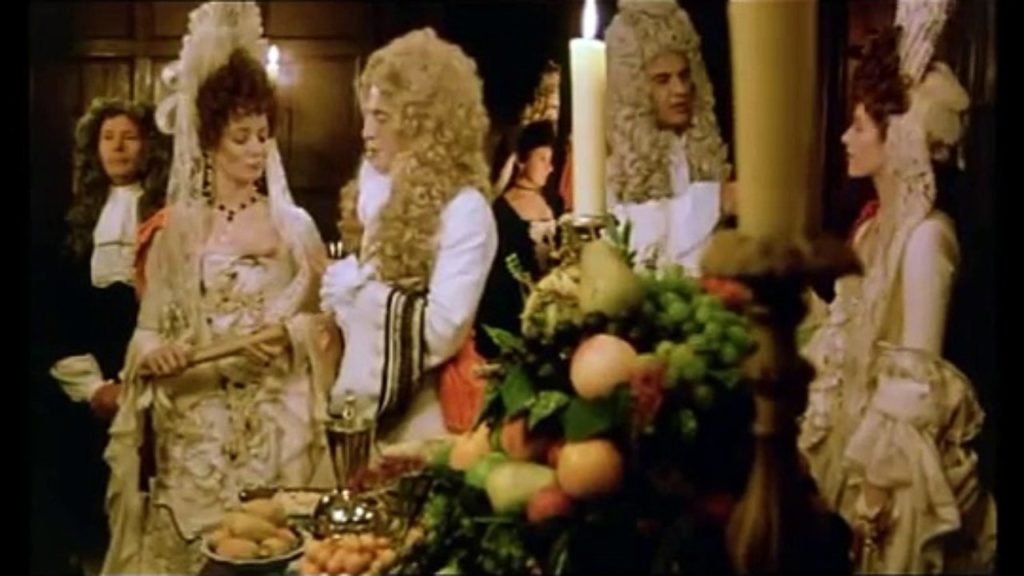
A comedy, though not one of manners (lack of manners, if anything) and a drama, The Draughtsman’s Contract is a satisfying if also somewhat impenetrable murder mystery. That latter aspect isn’t in the mix until later, though suspects and motives are trotted about the entire time. But, a word of advice: don’t strain yourself trying to solve this whodunnit. Greenaway reportedly took the film down from over three hours to its current 103-minute iteration by sacrificing most of the clarifying plot explanations. Ironically, by giving The Draughtsman’s Contract a more palatable run time, he made it less friendly to mainstream filmgoers. Ah well, who needs ‘em?
You may at this point be wondering, who is the draughtman (the British term for a technical illustrator, more or less), and what are the terms of his contract. R. Neville (played brilliantly by Anthony Higgins) is the draughtsman in question, just passing through the lush estate on his way from here to there. Aware of his professional reputation, or at least of his profession, the lady of the manor, Mrs. Virginia Herbert (Janet Suzman), proposes he stick around for twelve more days to render twelve drawing of the exterior property. The drawings will be a surprise for her husband, who is away at the moment. Neville, already booked out and busy, names terms for the job that are exorbitant, excessive, and degrading in hopes that that will be the end of it. How degrading? Per the titular contract, in addition to much money, Mrs. Herbert must avail herself sexually to him. Though she agrees, she finds his voraciousness in the bedroom quite alarming.
As Neville’s list of strict demands for the property fall on deaf ears (demands such as, “The west lawn must be free of all foot traffic and all sheep between the hours of…”), resulting in his intricate renderings including such unwanted clutter as ladders, errant garments, and even a stubborn foregrounded individual. (Fun fact: Greenaway dreamed up this film as he engaged in a similar exercise, drawing a vast estate over the course of consecutive days from established positions, for lighting consistency. Those are his hands doing the actual drawing in the movie). This self-important blowhard with the special attention of Mrs. Herbert strikes up the scorching disapproval of her impotent son-in-law, Mr. Talmann (Hugh Fraser), who barks, “He eats like a vagrant and dresses like a barber!”
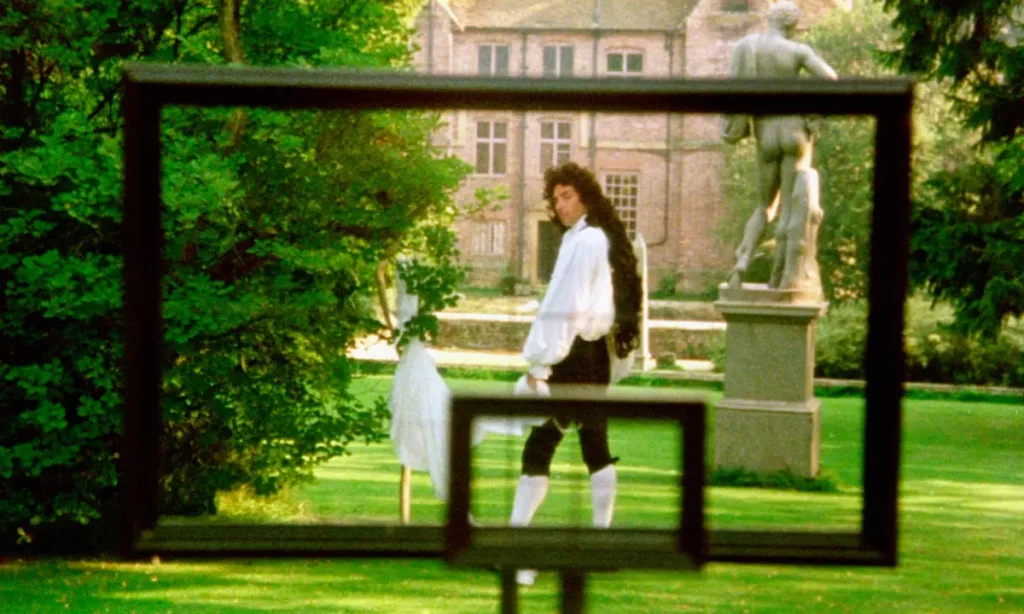
This intricate, blisteringly funny tale of an interloper loping about as if he owns the place only to learn that he most decidedly does not has scored a recent 4K restoration by the British Film Institute. That fortieth anniversary undertaking is beautifully represented on this new Blu-ray edition from Kino Lorber. (Greenaway enthusiasts also shouldn’t miss Kino’s double feature release of the A Zed & Two Noughts and The Falls, nor Severin’s 4K release of Drowning by Numbers). Lush greenery never felt so appropriately cold; stone castle interiors never felt so libidinously stale.
A fine selection of bonus features accompanies the feature. Things begin with an optional ten-minute video introduction by Greenaway, from about twenty years ago. The filmmaker is a fine host in this manner, and simply as neighborly and properly British as one imagines a Brit might be. He understands that his film, as it tends to be described, may hit some as an intimidating prospect. While he acknowledges and dives lightly into some of the layers of meaning and artworld references therein, he also assures that he ultimately wrote The Draughtsman’s Contract as a murder mystery in a manor house, and can certainly be enjoyed entirely on that level. This introduction is accompanied by clips of the film, some of which may be considered spoilery. As if that weren’t enough, Greenaway provides a detailed commentary track, as well.
Four deleted scenes make the cut, adding up to about twelve minutes. (It’s funny, actually… most of the bonus features on this disc that are specific to the feature presentation clock in around twelve minutes). The longest one involves Neville angrily bossing around a large number of servants to properly arrange a bunch of mismatched chairs outdoors, or some such. Anyhow, it’s fine that none of this material made the cut proper.
The film’s composer, the pianist, librettist, and musicologist Michael Nyman, is interviewed live onstage by David Thompson in a seven-minute video. It’s interesting to hear about Nyman’s varied career and how The Draughtsman’s Contract led him (though not exclusively) into the world of motion picture scoring.
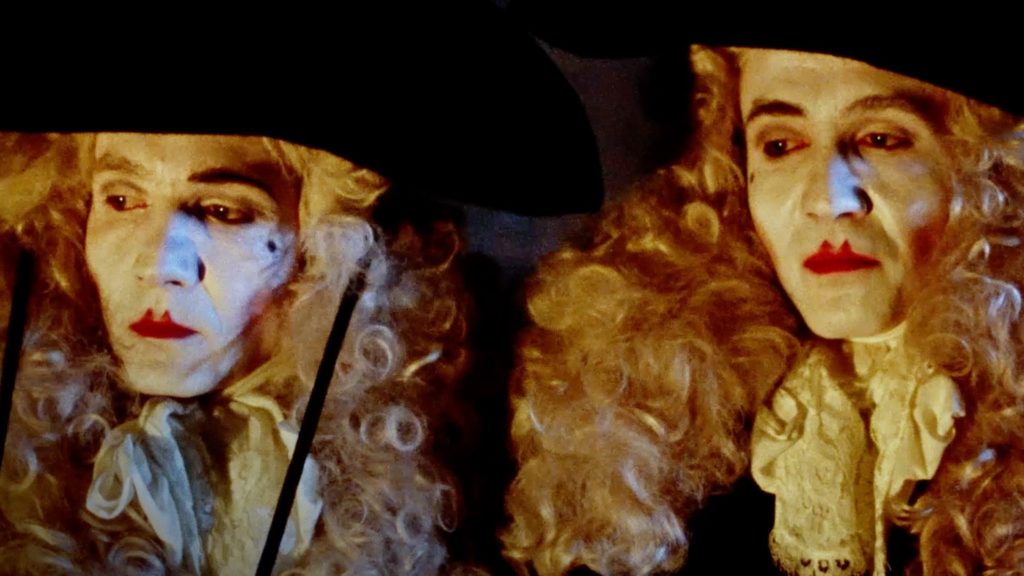
Ten minutes of behind-the-scenes footage from the film’s shoot are exactly that. Brief interview snippets are also included here. A recent re-release trailer boasting the 4K restoration is also viewable separately. Additionally, four of Greenaway’s early non-narrative, non-acted short films are included on the Blu-ray. Brief thoughts on each follow…
Intervals (1969) is a brief greyscale montage of a repeated handful of shots of sidewalk life in Venice. If nothing else, this signals Greenaway’s prowess as an editor as well as his unique eye to the world. But six minutes is about enough.
Windows (1974), running no more than four minutes, is dominated by a matter-of-fact narration delivering statistics with statistics about people who died as a result of falling or jumping from open windows. The visuals are mostly mere static shots of typical farmhouse windows shot from the inside looking out during a golden sunset. This film features harpsichord chamber music, not dissimilar to what’s heard throughout The Draughtsman’s Contract. The convergence of detached voiceover and the tragedy in the statistics it’s giving are indicative of Greenaway’s uncommon approach to come.
Dear Phone (1976) is a bit longer at about sixteen minutes. In it, we are shown handwritten and amended stories of people with the initials ‘HC’ who all have odd telephone habits and tales. The stories are dryly narrated as we simply are shown empty public telephone boxes. A pictural reminder that dull wit can still just be dull.
Water Wrackets (1975) is nothing but static shots of natural waterways in motion overlayed with a tinny, British, and unaffected academic voiceover detailing the campaigns of a fictious water-wracked army. The eleven-minute piece seems to drag by design, although maybe it simply drags. It plays not unlike one of those old 16mm educational filmstrips that we’d find ourselves trying to stay awake during in grade school but failing in that.
In having launched his career as an arthouse mainstay of highly artistically driven subversive features, Greenaway demonstrates that the astute painter or drawer or filmmaker paints or draws or films not only what they see but alsowhat they know. Neville the draughtsman, in his repressed work, clings to the rule of thirds. Greenaway does not. He is in fact quite often firing straight down the center of the frame and finding his target in most every incidence. The draughtsman’s contract may not be violated, but your expectations and notions of what this film may be very well will be.


